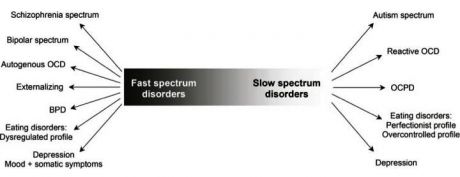Autism
Life History, The Diametric Model, and Sex Scandals
Evolutionary psychology integrates the diametric model via life history theory.
Posted November 1, 2014

As Marco Del Giudice, Amanda Klimczuk, Daniel Traficonte, and Dario Maestripieri remark in a recent paper published in Evolution and Human Behavior (left),
According to the diametrical model of autism and psychosis (Crespi & Badcock, 2008), autistic-like and schizotypal traits represent opposite sides of a mentalistic–mechanistic continuum of individual differences. A life history perspective puts the diametrical model in a broader context, suggesting that variation on the autistic-schizotypal axis may be maintained – at least in part – by the diametrical effects of autistic-like and schizotypal features on mating- and parenting-related behaviors (…).
The authors tested a number of hypotheses derived from this approach, specifically predicting a pattern of diametric associations between autistic-like and schizotypal traits and key behavioral correlates of life history strategy: “sociosexuality, impulsivity, and sensation seeking.”
Results were consistent with “the existence of a bipolar autistic-schizotypal axis of individual variation.” In support of their hypotheses, the authors found
clear diametrical associations between autistic-like and schizotypal traits and impulsivity, sensation seeking, and sociosexual behavior. These effects were not explained by correlations between the autistic–schizotypal axis and broad personality traits such as extraversion and openness to experience, corroborating the idea that autistic-like and schizotypal traits are functionally distinct from other dimensions of personality.
The authors sum up their approach as follows:
In a nutshell, schizotypy is regarded as a psychological phenotype oriented toward high mating effort and reduced parenting, consistent with a fast life history strategy (…). On the contrary, autistic-like traits are hypothesized to contribute to slow life history strategy characterized by reduced mating effort coupled with high parental investment.
A crucial issue here is monogamy: mating with one partner, as opposed to mating with multiple partners. If the multiple matings are simultaneous, the latter makes much greater demands on individuals’ mentalistic abilities than does monogamy, which involves a simple, one-to-one relationship. But even quite autistic people can manage a monogamous relationship in certain circumstances. And life-long monogamy in particular demands a high degree of single-minded commitment, honesty, and fidelity at which many high-functioning autistics excel.
Mating with more than one partner, by contrast, usually demands high levels of deceit—including self-deception—duplicity, and deviousness in general. Such mentalistic gifts are usually beyond the reach of even high-functioning autistics, and so it seems to me entirely plausible that Del Giudice and co. are right to suspect that sexual selection and life history factors have played a part in the evolution of the diametric mind.
Indeed, perhaps this explains why sex scandals are so common among the great and good (i.e., those with the best political and social skills) and are particularly associated with people in the vocations I listed in The Imprinted Brain as likely to attract those with superior mentalistic gifts: religious and ideological evangelism; literary and theatrical culture; litigation and the law; hypnosis, faith-healing, and psychotherapy; fashion and advertising; politics, public-relations and the media; commerce, confidence-trickery, and fraud of all kinds (p. 200).
Don Juans need to be smooth talkers, powerful persuaders, and clever manipulators: skills that also make all the difference in these vocations! Indeed, if we pursue the Iberian operatic theme, even Carmens have powers of seduction that are not simply physical, but mental too. At the very least, this may go some way to explaining why scientific, technological, engineering, and mathematical occupations (those where autistics can do well) are thought to be so boringly un-seductive—and certainly don’t attract the raucous razzmatazz of the showbizzy ones listed above.
It is also worth pointing out that institutionalized multiple mating—at least for men, what is normally known as polygyny—is the commonest form of marriage in indigenous African societies. Perhaps this partly explains the pattern of high mentalistic but low mechanistic IQ that the diametric model of intelligence suggests. And it certainly fits the case of Europe, where indigenous monogamy seems to go with the opposite cognitive configuration.
But however that may be, the authors are surely right when they add that their “results provide additional support for the life history approach to autistic-like and schizotypal traits, and demonstrate the heuristic value of this framework in the evolutionary study of personality and psychopathology.”

Finally, in a target article in Psychological Inquiry, Del Giudice attempts to provide “a general framework for the evolutionary analysis of mental disorders based on the concepts of life history theory” (diagrammed above). My colleague and co-author of the imprinted brain theory, Bernard Crespi, has already commented on this at some length (pp. 322-4), leaving me nothing to add, save a final quote from this ground-breaking study:
So far, the diametrical model of autism and psychosis and its extension in a life history perspective have proved both theoretically fertile and empirically fruitful. If future research will confirm the validity of this approach, we may finally come close to solving some of the most enduring puzzles in psychology and psychiatry.
(With thanks to Marco Del Giudice.)




